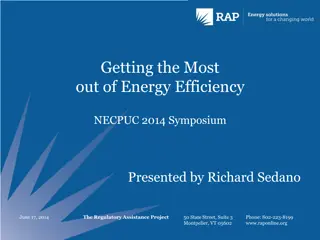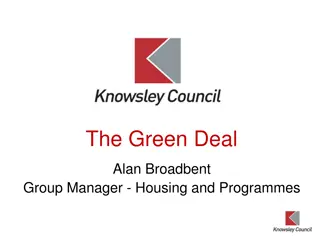Transitioning Towards Energy Efficiency: Co-Benefit Agenda of the Kigali Amendment
The Kigali Amendment proposes a framework to incentivize energy efficiency while phasing out high-GWP HFCs. Reports highlight the urgency to limit global warming to 1.5°C, emphasizing the need for deep emission reductions across all sectors. Investments in low-carbon technologies and energy efficiency must increase significantly. The future of cooling presents challenges and opportunities, with a focus on improving energy efficiency in air conditioning to reduce emissions. Transitioning to low-GWP refrigerants can have a positive impact on energy efficiency.
Download Presentation

Please find below an Image/Link to download the presentation.
The content on the website is provided AS IS for your information and personal use only. It may not be sold, licensed, or shared on other websites without obtaining consent from the author.If you encounter any issues during the download, it is possible that the publisher has removed the file from their server.
You are allowed to download the files provided on this website for personal or commercial use, subject to the condition that they are used lawfully. All files are the property of their respective owners.
The content on the website is provided AS IS for your information and personal use only. It may not be sold, licensed, or shared on other websites without obtaining consent from the author.
E N D
Presentation Transcript
Co-benefit Agenda of the Kigali Amendment A proposed framework to incentivise energy efficiency while transitioning away from high-GWP HFCs Chandra Bhushan Deputy Director General Centre for Science and Environment
Outline Three reports and similar prognosis: IPCC special report on the impacts of global warming of 1.5 C above pre-industrial levels TEAP s Final report on issues related to energy efficiency while phasing down hydrofluorocarbons IEA s report on The Future of Cooling: opportunities for energy efficient air conditioning
The IPCC 1.5C Report At current rate, we are set to cross 1.5 C between 2030- 2052.
IPCC 1.5C Report Key Takeaways Limiting warming to 1.5 C requires rapid and deep reductions in emissions in all sectors. Building sector, responsible for one-third of global energy consumption, must reduce emissions by 80-90 per cent by 2050. Marked shift in investment patterns -- investments in low-carbon energy technologies and energy efficiency will have to approximately double in the next 20 years.
IEAs Report: The Future of Cooling Global sales of ACs quadrupled since 1990 to reach 135 million units per year. About 1.6 billion units currently, with over half of them in just two countries China and the US consuming 2,000 TWh of electricity every year The global stock for ACs will grow from to 5.6 billion by 2050, with most growth in Asia and Africa, requiring 6,200 TWh electricity by 2050. * Growth also in Europe due to rising temperature
IEAs Report: The Future of Cooling With stringent MEPS, the average energy efficiency of the stock of ACs worldwide can be more than doubled between now and 2050. This can reduce energy demand from the ACs by half, equivalent to emissions saving of 500 million tonne per year. Coupled with decarbonisation of power generation, CO2 emissions from ACs can be reduced to just 150 million tonne by 2050, compared to 1,130 million tonne today . This would be in line with the CO2 reduction trajectories to meet the 1.5 C target.
TEAPs Final report on energy efficiency Low GWP refrigerants are expected to have an impact on the system efficiency, which is likely to be within 5% of the baseline refrigerant(s) in terms of energy performance. The direct benefits of the reduction of high GWP refrigerants during the phase down might be offset by the use of less energy-efficient equipment. If Kigali amendment resulted in the use of more energy- efficient equipment, the total reduction of greenhouse gases emissions both from direct and indirect sources, could double that. What kind of a deal would allow this co-benefit agenda to happen?
Montreal Protocol & Energy Efficiency Ambivalent attitude towards energy efficiency. During phasing out of CFCs, MLF deducted any costs towards energy efficiency improvement, as it was considered to be a technology upgrade. Chiller projects: The ExCom decided that assessment should be done on the basis of Total Equivalent Warming Impact (TEWI) in selecting an alternative technology. But energy savings, should be deducted from the incremental costs.
Montreal Protocol & Energy Efficiency Decision XIX/6, which accelerated the phase-out of production and consumption of HCFCs. To encourage Parties to promote the selection of alternatives to HCFCs that minimise environmental impacts, in particular impacts on climate, as well as meeting other health, safety and economic considerations Climate incentive Multilateral Fund Climate Impact Indicator (MCII)
Montreal Protocol & Energy Efficiency Climate incentive: funding of up to a maximum of 25% above the cost-effectiveness threshold when needed for the introduction of low-GWP alternatives. Multilateral Fund Climate Impact Indicator (MCII): A tool that provides an indication of the effect on the climate associated with the conversion of enterprises from HCFC-22 (baseline) to alternative refrigerants. It takes into account both direct and indirect emissions. * The experience gained in applying the MCII had shown that the potential climate impact of the conversion of refrigeration and air-conditioning equipment from the baseline (HCFC-22) to alternative refrigerants can be measured objectively and systematically, and enables the Executive Committee to monitor and account for the potential climate impact of the projects supported by the Multilateral Fund . (Decision 69/23)
Montreal Protocol & Energy Efficiency Kigali Amendment Decision XXVIII/2: requests the ExCom to develop cost guidance associated with maintaining and/or enhancing the energy efficiency of low-GWP or zero-GWP replacement technologies and equipment, when phasing down hydrofluorocarbons, while taking note of the role of other institutions addressing energy efficiency, as appropriate. It is quite clear that the ExCom and the MLF have had an experience of dealing with energy efficiency issues during the CFC phase-out as well as during the HCFC phase-down. Can these experiences be utilised for enhancing energy efficiency during HFC phase-down?
Energy efficiency & RAC sector Energy efficiency has its own co-benefits. These co-benefits get translated into economic benefits for the local and national economy. Despite being a low-hanging fruit, there are barriers to enhancing energy efficiency in developing countries. Removing them would require resources to fill the gaps in private sector investments. Labelling programmes and Minimum Energy Performance Standards (MEPS), driven nationally, has been the key for improving energy efficiency. MEPS have proved to be the single most effective policy measure for boosting efficiency.
Energy efficiency & RAC sector Considerable scope for tightening MEPS, as the energy efficiency of available appliances is significantly more than the average efficiency of equipment sold in the market. Large amount of funds available from multilateral and bilateral sources to support energy efficiency, but it is not targeted at the appliance sector. Energy efficiency improvements have been largely driven through regulations and paid for by consumers. The Montreal Protocol s efforts towards co-financing for additional resources to maximise environmental benefits during HPMPs have not materialised. In fact, many of the mechanisms for co-financing were found to be incompatible with the requirements of the MLF.
Incentive and not incremental cost The co-benefit of energy efficiency for the domestic market, the private sector investment in energy efficiency, the increased price paid by consumers etc. makes calculation of Incremental Cost highly complicated and subjective. To remove barriers, the concept of Incentive is more suitable than Incremental Cost.
The proposed framework Like climate incentives during HPMPs, Parties should agree to the concept of Energy Efficiency Incentive (EEI) during HFC phase down. The objective of the Energy Efficiency Incentive (EEI) should be to push for improvements in the MEPS. Incentive should be given only when an enterprise proposes to improve energy efficiency beyond certain threshold above the MEPS. An additional funding of at least 25 per cent above the cost-effectiveness threshold should be earmarked for the EEI.
The proposed framework MCII tool should be remodeled to improve the energy efficiency aspect. The tool should then be used to assess proposal and approve EEI. Instead of asking parties to look for other sources of co-funding, MLF should be authorized to raise funds from other multilateral sources to fill the gap in funding energy efficiency improvements























